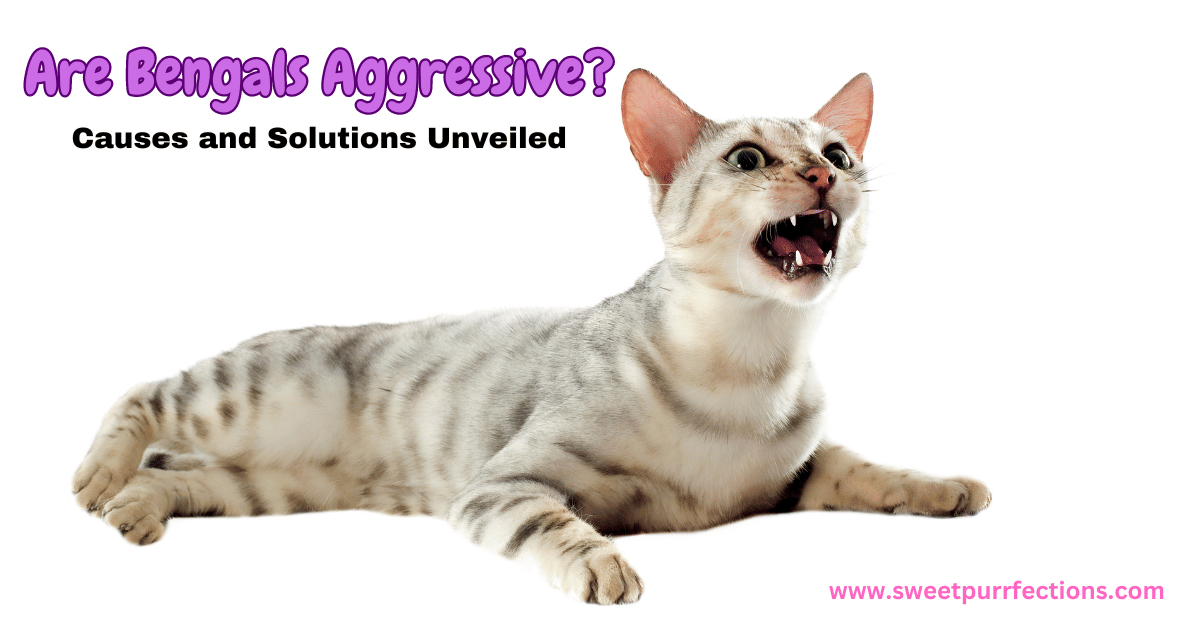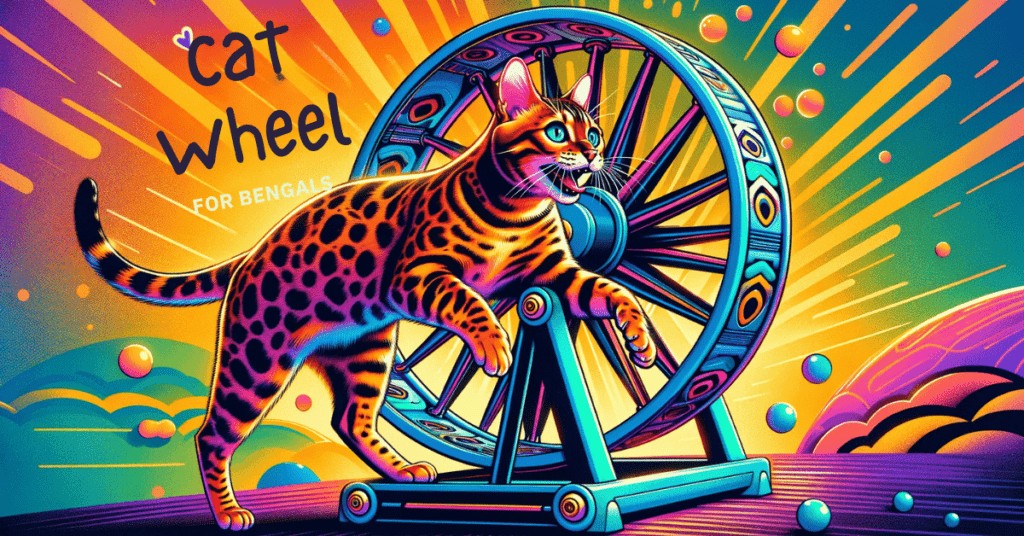This post contains affiliate links and I will be compensated if you make a purchase after clicking on my links.
Are Bengal Cats Aggressive? The Facts Unveiled
Bengal cats, part Asian leopard cat and part domestic feline, have a unique allure with their wild appearance and playful demeanor. With their striking coat patterns and energetic behavior, it’s safe to say they look a bit wilder than many other cat breeds. However, a common question arises: Are Bengal cats aggressive?
Yes, Bengal cats can exhibit aggressive behavior, and there have been instances where they have shown aggression towards their human companions or other animals. However, this aggression typically occurs when they are bored or understimulated.
In this post, we will delve into the various reasons behind this behavior and explore effective solutions to ensure your Bengal cat remains a happy and affectionate pet.
Aggression in Cats: What Does It Mean for Bengal Cats?
Aggression in cats can manifest in various forms, and understanding these can help you better manage and prevent such behaviors in your Bengal cat. Let’s break down what aggression means in the feline world and how Bengal cats might differ or align with other breeds.
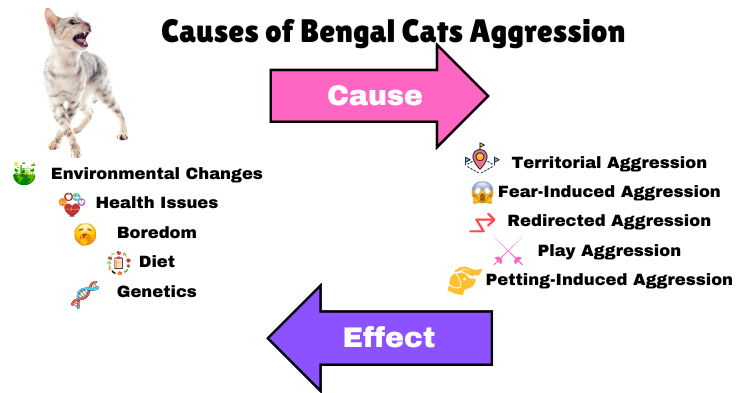
Defining Aggression
Aggression in cats can be quite complex and may present itself in several ways:
- Territorial Aggression: Aggression shown when a cat feels its space is being invaded by another animal or a new person.
- Fear-Induced Aggression: Defensive aggression that occurs when a cat feels threatened or scared.
- Redirected Aggression: Aggression directed at a person or another animal because the cat cannot reach the actual source of its frustration, such as seeing another cat outside the window.
- Play Aggression: Common in younger cats, this involves playful biting and scratching due to their hunting instincts and high energy levels.
- Petting-Induced Aggression: Sudden aggression during petting, often because of overstimulation or sensitivity in certain areas.
Common Causes of Aggression
There are several factors that can lead to aggression in cats, including Bengal cats:
- Environmental Factors: Changes such as moving to a new home, introducing a new pet, or rearranging furniture can stress cats and trigger territorial or fear-induced aggression.
- Health-Related Issues: Pain or discomfort from health problems can cause any form of aggression. Always consult a vet if your cat’s behavior changes suddenly.
- Behavioral Triggers: Lack of stimulation and boredom, especially in active breeds like Bengals, can lead to play or redirected aggression. Ensure they have enough mental and physical activities.
- Dietary Factors: Poor nutrition or sudden changes in diet can contribute to behavioral issues, including aggression. A balanced diet helps maintain stable behavior.
- Genetic Predisposition: Some Bengals may have a natural tendency to be more assertive due to their genetics, which, under certain conditions like stress or lack of stimulation, can contribute to aggressive behavior.
How Bengal Cats Compare
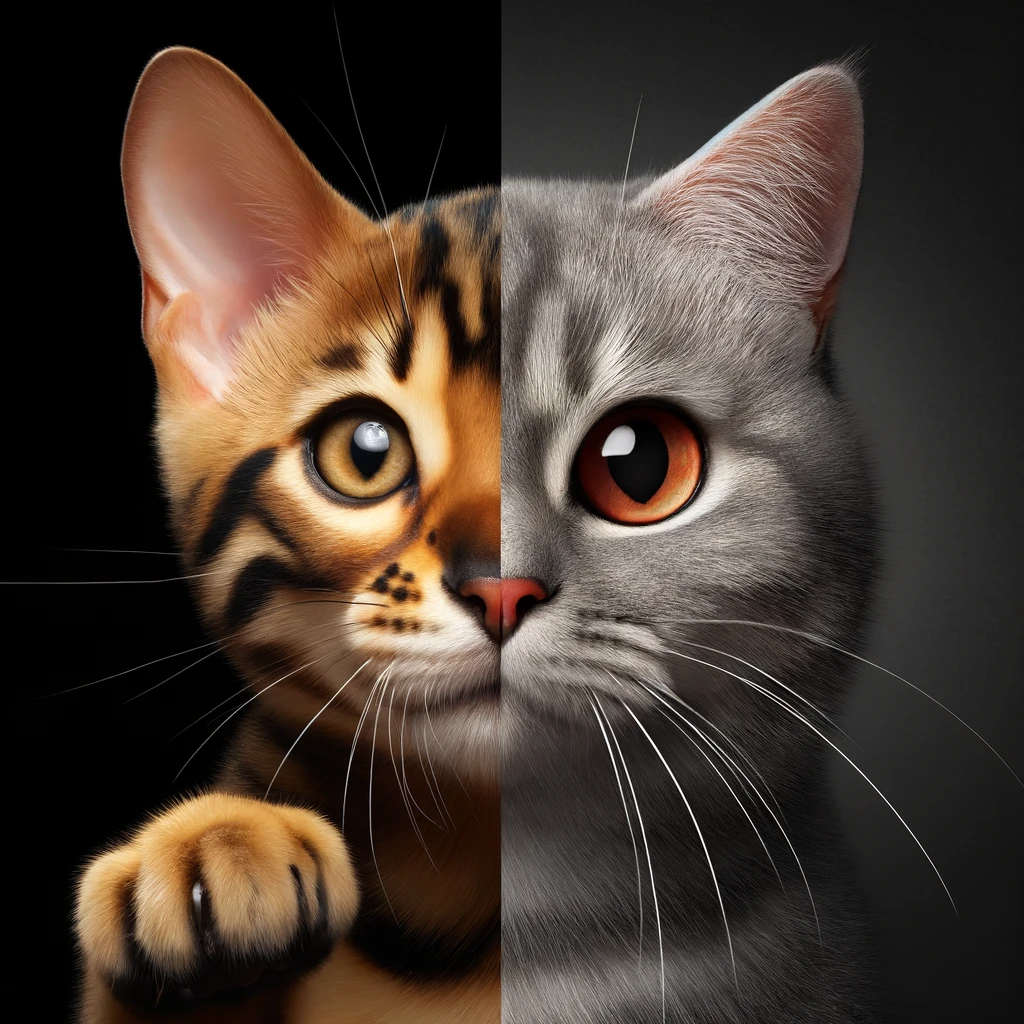
Bengal cats are known for their high energy levels and playful nature, which can sometimes be mistaken for aggression. Here’s how they compare to other breeds:
- Activity Level: Bengals require more physical and mental stimulation compared to many other cat breeds. Without sufficient engagement, they might display aggressive behaviors out of sheer frustration or boredom.
- Interaction with Humans and Pets: While Bengals can be affectionate, they also have a strong prey drive and can be more assertive in their interactions. This doesn’t mean they’re naturally aggressive, but they do need proper socialization and training.
- Curiosity and Intelligence: Bengals are incredibly curious and intelligent. They require mental challenges to stay occupied. Puzzle feeders, interactive games, and training sessions can help channel their intelligence into positive behaviors, reducing the likelihood of aggressive outbursts.
- Vocalization and Communication: Bengals are often more vocal than other breeds, using a variety of sounds to communicate their needs and emotions. This high level of communication can sometimes be misinterpreted as aggression, especially if the cat is trying to express frustration or seek attention.
Fact: Early-generation Bengals tend to be quieter, a nod to their wild ancestors where silence was key for survival. But when it comes to chatty Bengals, it’s all in the genes! Some lineages are naturally more talkative, making their voices a charming part of their personality.
Managing and Preventing Aggression
Preventing and managing aggression in Bengal cats involves a combination of proper care, socialization, and understanding their unique needs.
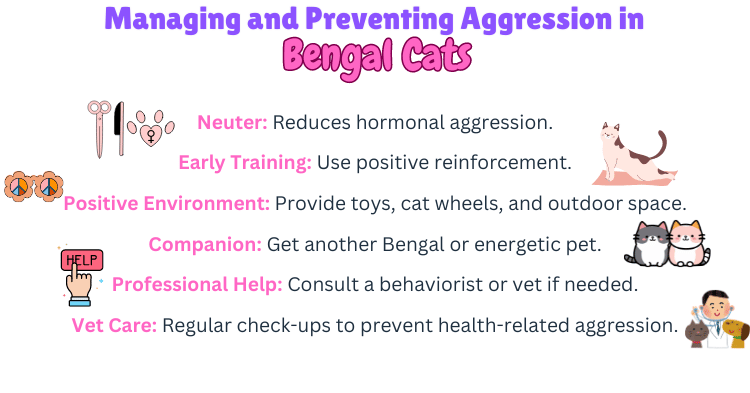
Neutering
Neutering your Bengal, whether male or female, is a game-changer. It eliminates the strong drive to roam and mate, which can lead to aggressive encounters with other cats.
Unfixed Bengals are more prone to aggression as they seek out a mate. Neutering removes these hormonal urges, making them less likely to fight, spray, or exhibit other aggressive behaviors. Plus, it cuts down on other pesky behaviors like excessive vocalization, destructiveness, and mouthiness.
Training and Socialization
Start training and socializing your Bengal cat from a young age using positive reinforcement techniques to encourage good behavior and discourage the bad.
Bengals are territorial and can be aggressive toward other cats, but that doesn’t mean you can’t have a multi-cat household. It’s best to introduce new cats while they are still kittens. However, due to their predatory nature, avoid mixing Bengals with smaller animals like rabbits, guinea pigs, hamsters, gerbils, birds, and fish.
Creating a Positive Environment
Bengals thrive in larger homes, ideally with safe outdoor spaces where they can explore and stay stimulated. Cats, in general, love the outdoors, and Bengals even more so. If you live in a small apartment, don’t worry—just provide plenty of interactive toys and activities to keep them engaged.
A cat wheel is a must to help them burn off energy, and taking them out on leash walks can satisfy their adventurous spirit. Interactive toys, puzzle feeders, and regular playtime are essential for their mental and physical well-being. Additionally, make sure they have a safe space to retreat and feel secure.
Get a Companion for Your Bengal
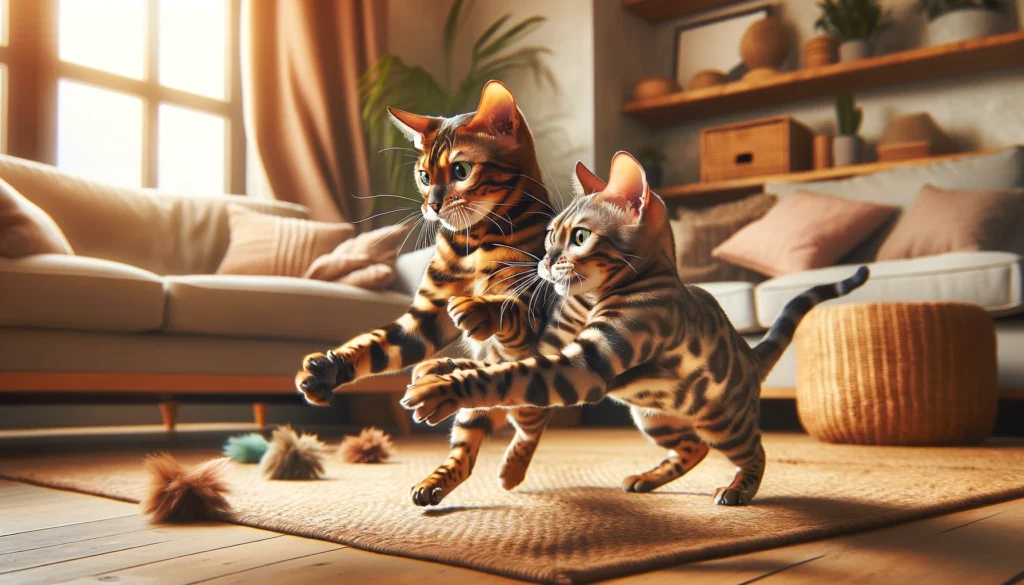
If your Bengal is showing bad behavior, one of the best solutions is to get another Bengal, ideally from the same litter. If that’s not possible, consider another Bengal, another cat, or even a cat-friendly dog that matches their energy.
Make sure all pets in your multi-pet household have similar energy levels to avoid any discomfort or tension among them. This can help keep your Bengal engaged and happy, reducing unwanted behaviors.
When to Seek Professional Help
If your Bengal’s aggression is severe or doesn’t improve with environmental changes and training, seek help from a professional animal behaviorist or a veterinarian specialized in feline behavior.
They can determine the underlying reasons, identify if your correction methods need adjusting, or if past incidents have damaged your relationship with your cat, and provide tailored strategies to address your cat’s specific needs.
Addressing Health Issues Promptly
Regular veterinary care is crucial. If you notice any changes in your cat’s behavior, it’s important to consult a vet to rule out any underlying health issues. Early detection and treatment can prevent aggression related to pain or discomfort.
Pro Tip: Instead of punishment, focus on understanding your Bengal’s behavior. Physical punishment is a big no-no—it can damage your relationship with your cat and make issues worse. Positive reinforcement and patience are key to fostering a happy, well-behaved feline friend.
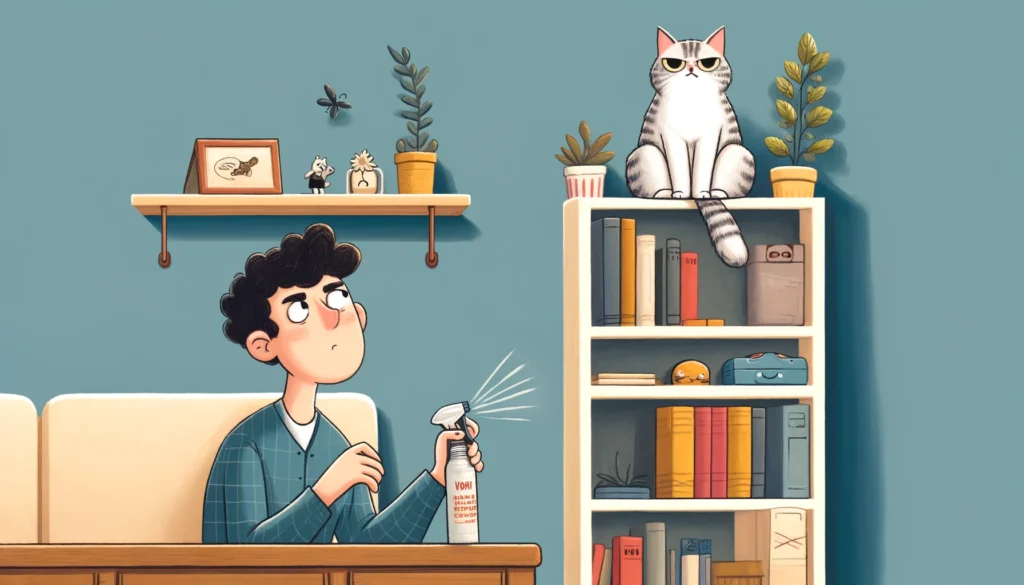
Ensuring a Happy and Affectionate Bengal Cat
Bengal cats might have a bad reputation for aggression, but most cat breeds can show bad behavior if there’s a cause. We’ve discussed the key factors: understanding different forms of aggression, the importance of socialization and a stimulating environment.
Remember, it’s our job to identify the cause of any aggression, understand animal behavior, and address it appropriately. With the right care and environment, Bengal cats can be loving and affectionate companions.
Meet Sean, a fintech whiz with a penchant for pet purrs and blockchain buzz. After a decade of fintech feats, Sean’s tech talents leaped from ledger lines to litter lines, driven by a passion for pets and a vision for a more connected pet care community. With three critter companions as co-pilots, Sean launched this blog to share a treasury of pet-friendly tech tips and tales.

